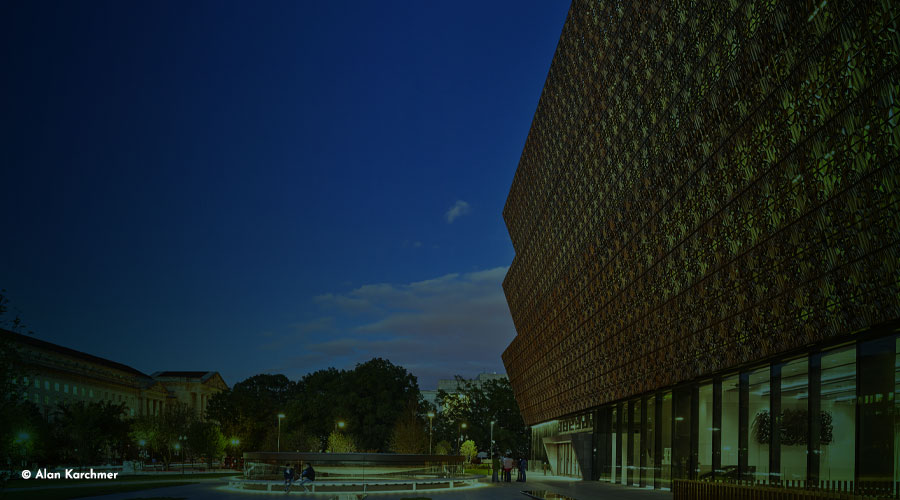On September 24, 2016, the 19th museum of the Smithsonian Institution opened to the public: the National Museum of African American History and Culture (NMAAHC). Established by an Act of Congress in 2003, the NMAAHC highlights the contributions of African Americans throughout our country’s history. It features interactive exhibits where patrons can explore and collaborate on African American culture and see how our histories were shaped by issues, including slavery, war and civil rights movements worldwide. As of 2020, the museum is home to more than 36,000 artifacts, and nearly 100,000 individuals have become members of the NMAAHC.
Unfortunately, the NMAAHC was closed to the public for months in 2020, and patrons could not visit the extensive collections in person. To counter this problem, the museum hosted an expansive roster of digital programming, as well as new online initiatives and events, in the last month of 2020.
With “Artists at Home: School Outreach,” the museum hosted an interactive art program for middle and high school students every Tuesday and Thursday in October, November and December. Each hour-long session was led by a NMAAHC educator and focused on a unique African American artist. As part of the program, students were also encouraged to create their own works of art with materials from home. While the event was not recorded, if you are interested in participating in similar events with your students, then check the website frequently for upcoming events.
On December 3rd, the NMAAHC collaborated with Smithsonian’s National Air and Space Museum to sponsor a virtual discussion with NASA Astronaut Victor Glover, the first African American astronaut to take long-term residence on the International Space Station (ISS). During the Q&A event, Glover discussed the mission’s objectives, his work in space and his career from the ISS. You can still view this virtual event on the NMAAHC website even in the new year.
The following week, on December 14th, there was also a live-streamed panel entitled “Historically Speaking: Mayoral Leadership in the Time of COVID-19,” which was moderated by Michel Martin, host of NPR’s Weekend All Things Considered. The program focused on the impact of the visus, flattening the curve and other events of 2020. Watch this one-of-a-kind program in 2021 at your convenience.
While all three of these virtual events were exciting and offered viewers a unique historical perspective, the most anticipated event of the month was “24 Hours in a Time of Change.” On Friday, December 11th, 10 Smithsonian museums and cultural centers partnered together to host virtual programs centered on contemporary issues, sparking a national dialogue of what it was really like to live through this moment in history. Topics included the pandemic and social injustice, and each session prompted patrons to reflect and post their struggles on the website to be cataloged. Some sessions of the day included Grassroots Responses on the Navajo and Hopi Reservations and Writing My Resilience.
Aside from moderated virtual events, the NMAAHC also launched a webpage on Kwanzaa, which is a digital resource dedicated to exploring the holiday’s history and traditions. The page is full of interactive content and projects for families to enjoy, including a blog, recipes, book recommendations and sing-a-longs, as well as information on the holiday’s origins from museum oral historian Kelly Navies.
Lastly, in celebration of the 75th anniversary of Ebony Magazine, the NMAAHC launched a webpage paying homage to Ebony’s contributions to African American photojournalism. “The 75 Years of Ebony” feature includes a digital collection of quotes from editors and change-makers, photographs from the magazine and information about historical events, including the court cases that shaped the Civil Rights Movement, such as Morgan v. Virginia (1946) and Henderson v. The United States (1950).
Robert F. Smith’s Lasting Impact on the NMAAHC
Robert F. Smith has long championed the NMAAHC, even before it officially opened to the public. Indeed, his $20 million gift in September 2016 has allowed the museum to expand their technological offerings — something that became even more vital to the museum’s outreach efforts in 2020. Considered to be one of the largest donations to the museum by an individual, Smith’s contribution helped with digitization efforts like the Robert F. Smith Explore Your Family History Center, as well as to preserve and promote African American history and culture within the museum.
“I am thrilled to bring the transformative power of technology to celebrate and conserve the African American experience in America,” said Smith of his gift. “It is so fitting that this beautiful building on the National Mall, where Martin Luther King stood just steps away during the March on Washington, will serve as a living tribute and custodian of our rich history.”
While many of the museum’s programs were financed in part, or in whole, by Smith’s gift, some of the highlights include the Community Curation Program, the Great Migration Home Movie Project, the Robert F. Smith Internship Program, Robert Frederick Smith Applied Public History Fellowship, the Professional Curation Program and the Robert Frederick Smith Explore Your History Center, the arguably most famous program at the museum to bear his name. The Robert Fredrick Smith Explore Your History Center allows visitors of the museum to learn their family’s history and the basics of researching African American genealogy. Currently, visitors may register for virtual genealogy research sessions and attend public programs online.
Learn more about the National Museum of African American History and Culture and their online programs, digital resources and mobile app.






